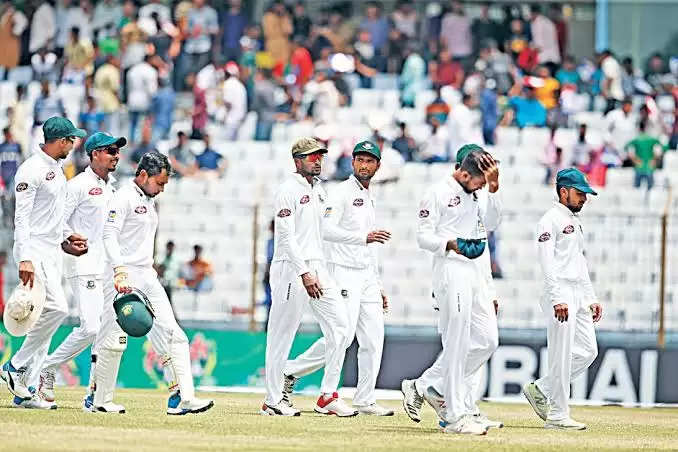What lies ahead for Bangladesh?

A small but proud cricketing nation, Bangladesh has taken giant strides in international cricket especially in the shorter formats. But as far as the longest format is concerned, their growth never happened as it was expected to. In their first series of the ICC World Test Championship, they have been absolutely annihilated by a confident Indian side as they lost both their Tests against the hosts inside three days without showing any kind of fight.
While many would say that the result was not a shocking one, the manner of the defeat was, especially after the growth of Bangladesh cricket as a whole. The inability of the players to put up a fight coupled with the inexperience due to the absence of key players like Shakib Al Hasan and Tamim Iqbal badly hurt Bangladesh.

Where is Bangladesh’s cricket heading? What needs to be done? What could have possibly gone wrong that their growth as a Test nation is not as good as that in other formats? The questions are manifold but the answers very few.
Bangladesh have played 117 Tests and have managed to win only 13 of them among which 9 were won at home on turning tracks. With 88 losses, they never seemed to improve as a team even though they had the experience of players like Shakib, Tamim, Mahmuduallah and Mushfiqur Rahim. There was a time where they used to compete in every Test they played and also managed to beat England at home and Sri Lanka in their own den. But, their loss in the one-off Test against a nation like Afghanistan who has just received Test status itself tells a lot about the condition of the Test team off late.
After the retirement of Mashrafe Mortaza, Shakib was looked upon as a true hero by the Bangladesh cricket fans and was seen as a true role model by many young and budding cricketers. He showed how good an all-rounder he is in the recently concluded Cricket World Cup. But the entire nation went in shock when it was announced that he will be banned for two years with a suspended period of a year due to him failing to report three bookie approaches. Before the beginning of every tour, the teams are briefed about anti-corruption and sportsman spirit and so it is more perplexing to think how can such a huge icon of the game commit such a mistake that would not only cost him but also his nation.
There are a lot of problems at the grassroots level in Bangladesh too. Before getting banned, Shakib was leading a strike by the cricketers in order to double their wages and he was pretty vocal about the poor facilities that are provided to the young domestic cricketers and also to the national team. Although the board later agreed to increase the wages of the players, it is the quality of the infrastructure available that is also hurting Bangladesh cricket. The National Cricket League (NCL) is the premier domestic tournament in Bangladesh cricket and many players from the national team do not take it seriously and the quality of cricket played is very low.
Current skipper Mominul Haque after the Test series against India also spoke about how fast bowlers need to be encouraged in Bangladesh as they do not get the practice they need due to the spin-friendly domestic wickets. Players like Abu Jayed showed promise but inconsistencies in line and length are what always punished them.
The Bangladesh Cricket Board (BCB) had taken a few steps by making it compulsory for teams to play a leg spinner and a bowler who bowls above 140 kmph in the Bangladesh Premier League (BPL) keeping in mind next year’s T20 World Cup is in Australia. But it is the NCL that needs to be structured properly and the pitches need to be doctored to suit both the pacers as well as the spinners.
Adversity for one means opportunity for others and that is exactly what the youngsters in the domestic circuit and the fringe players must think. The absence of Shakib is a big blow but it also provides an opportunity for someone else to come of age and shine as a cricketer.
When changes need to be made at the fundamental level, the rebuild will take a certain amount of time and thus now the focus of the board should be more on increasing the pool of quality players rather than just thinking about the result of the games. There is definitely a lot of talent available with players like Mohammad Naim who impressed with the Bangladesh A side and also in the T20s against India.
The team management must start scouting for more role-specific players and specialists in their respective position. In this phase seniors like Mahmudullah and Mushfiqur Rahim must step up and bat up the order and also mentor the youngsters to perform well. In one year’s time, Shakib will be back from suspension and Bangladesh now have the time to find the missing pieces in the jigsaw and groom them to take Bangladesh cricket forward.
Bangladesh Cricket Board can take the lessons from the BCCI in terms of change in the culture right from the domestic level, especially in the fast bowling department. Ranji Trophy pitches started to be made more bowler-friendly and Indian skipper Virat Kohli introduced his fitness regime into the team and this has been a process of 3-4 years which is now reaping rewards in the form of the Indian pace attack firing all cylinders. Patience is the key and the right structure domestically is another important factor that can take Bangladesh cricket to newer heights.
If Bangladesh Cricket Board follow the principle of patience and invest more financially as well as psychologically into grooming young talented cricketers, surely one day the Bangla Tigers will roar in the game’s longest format, but right now that appears farther than the horizon.

